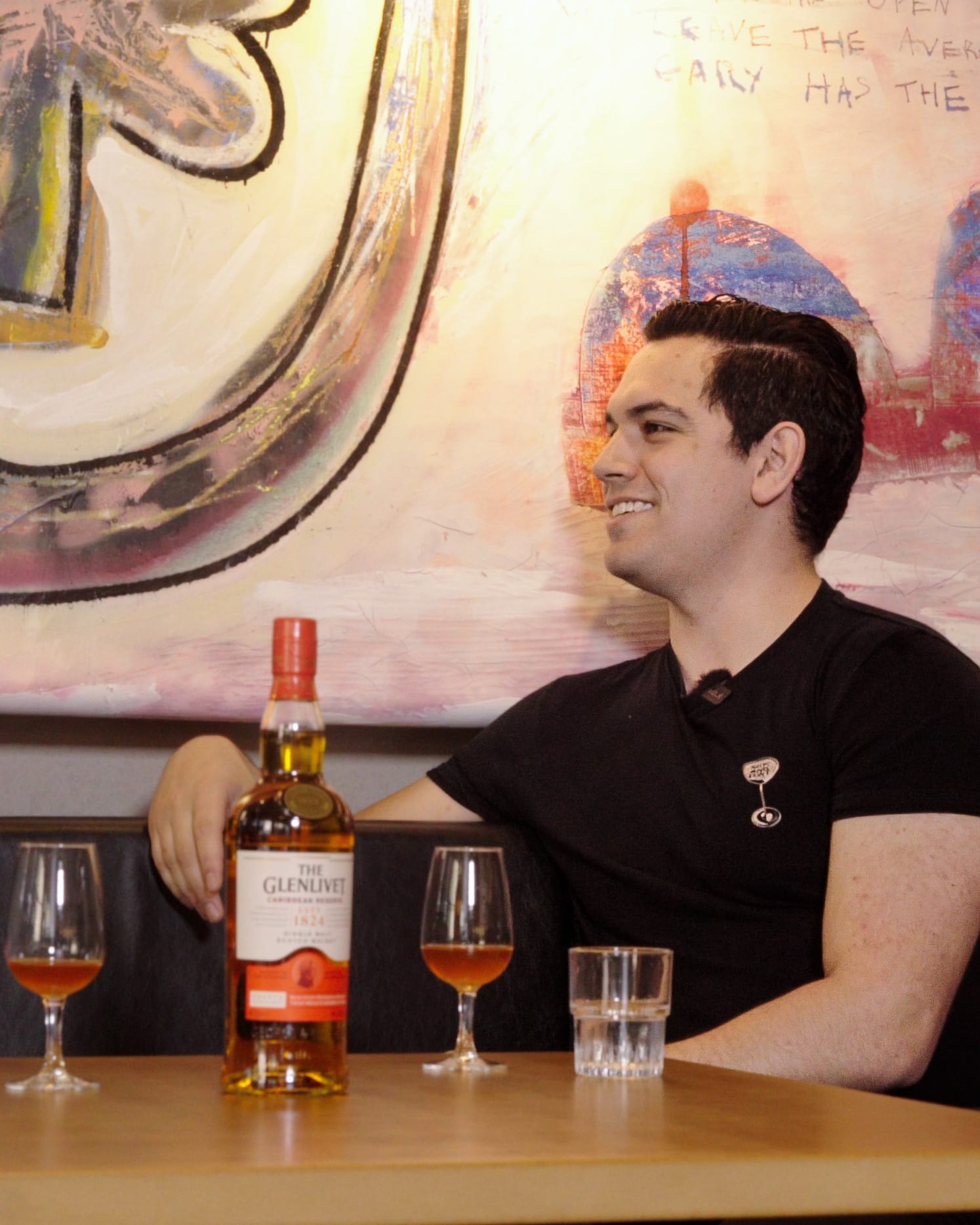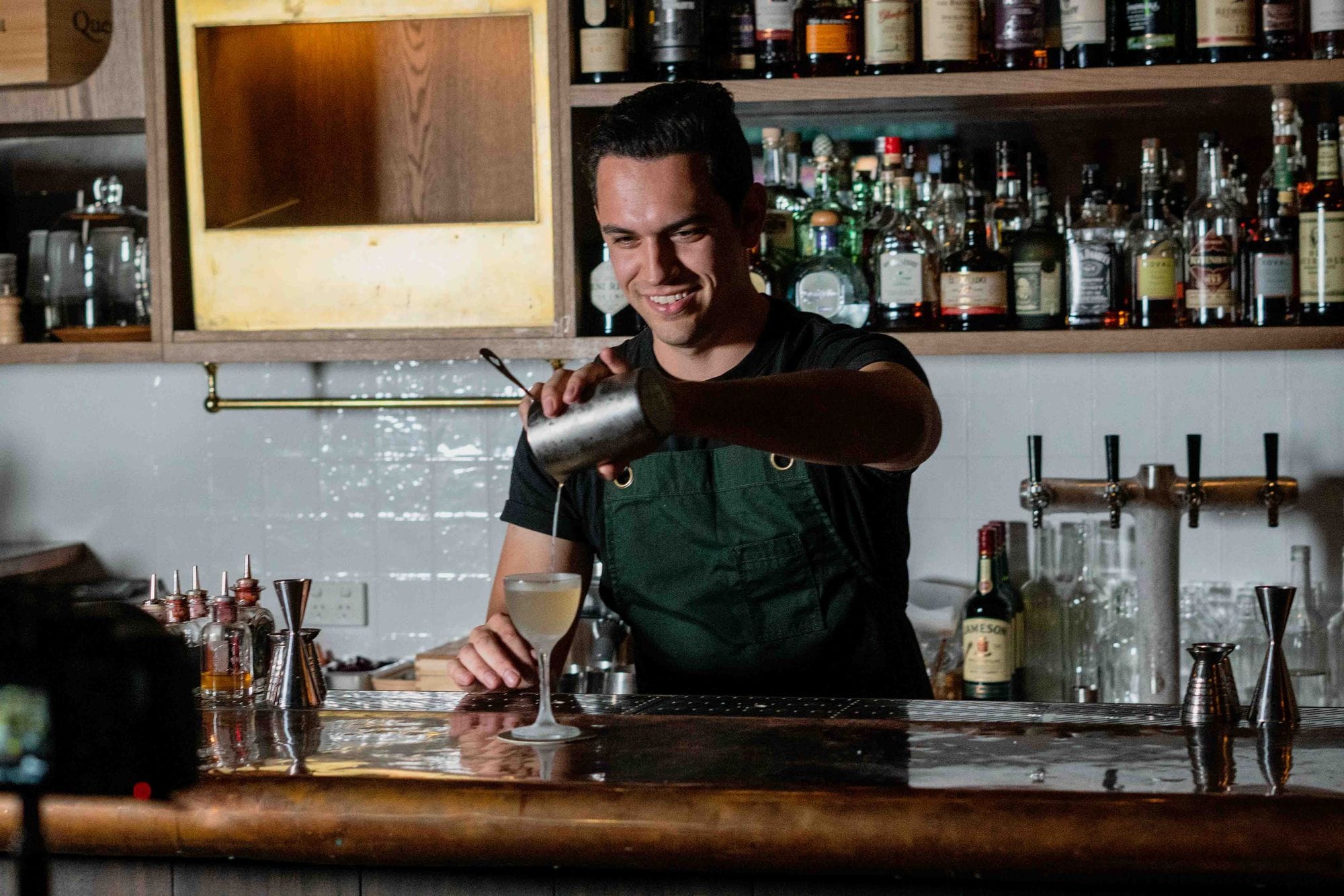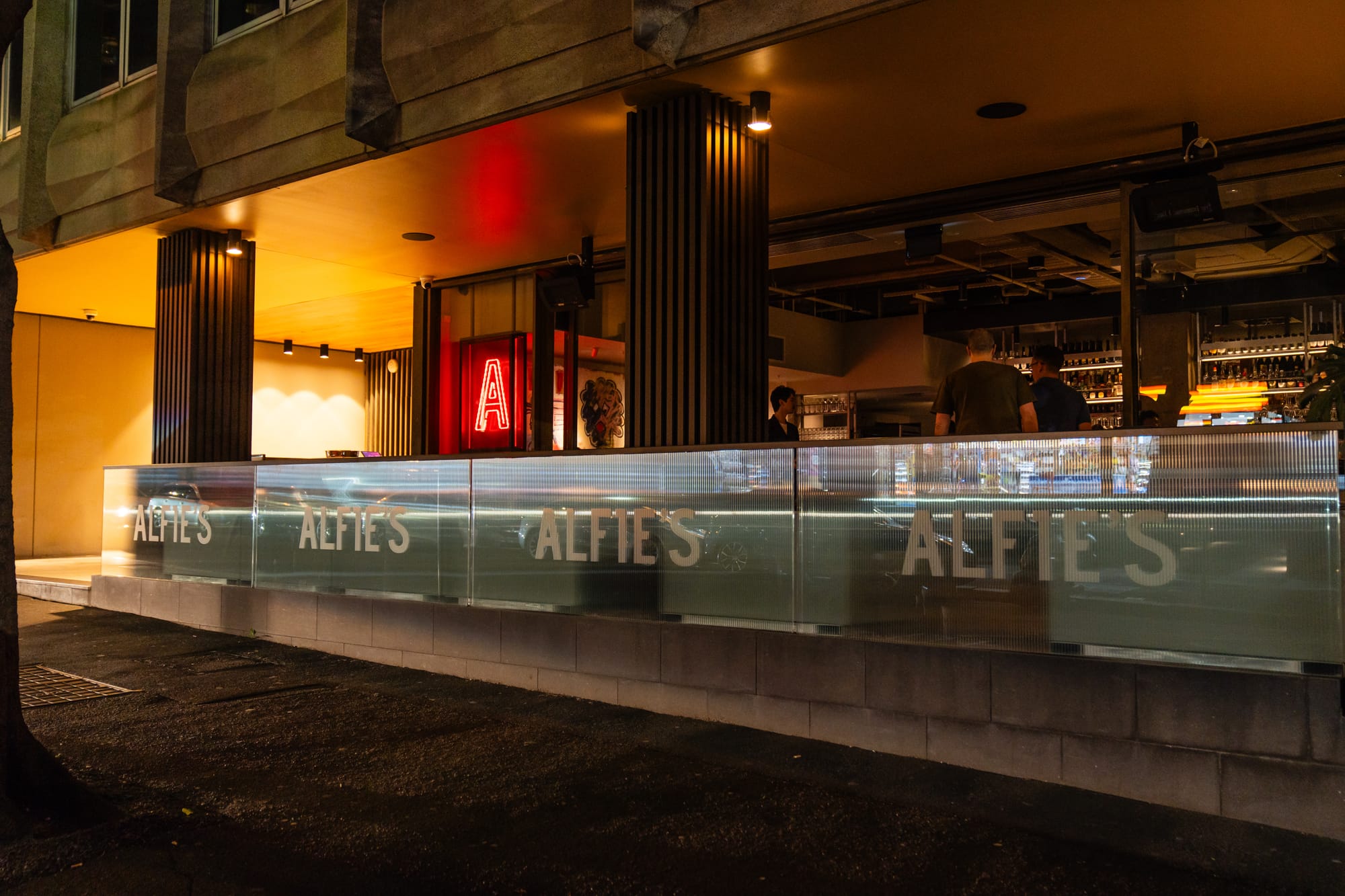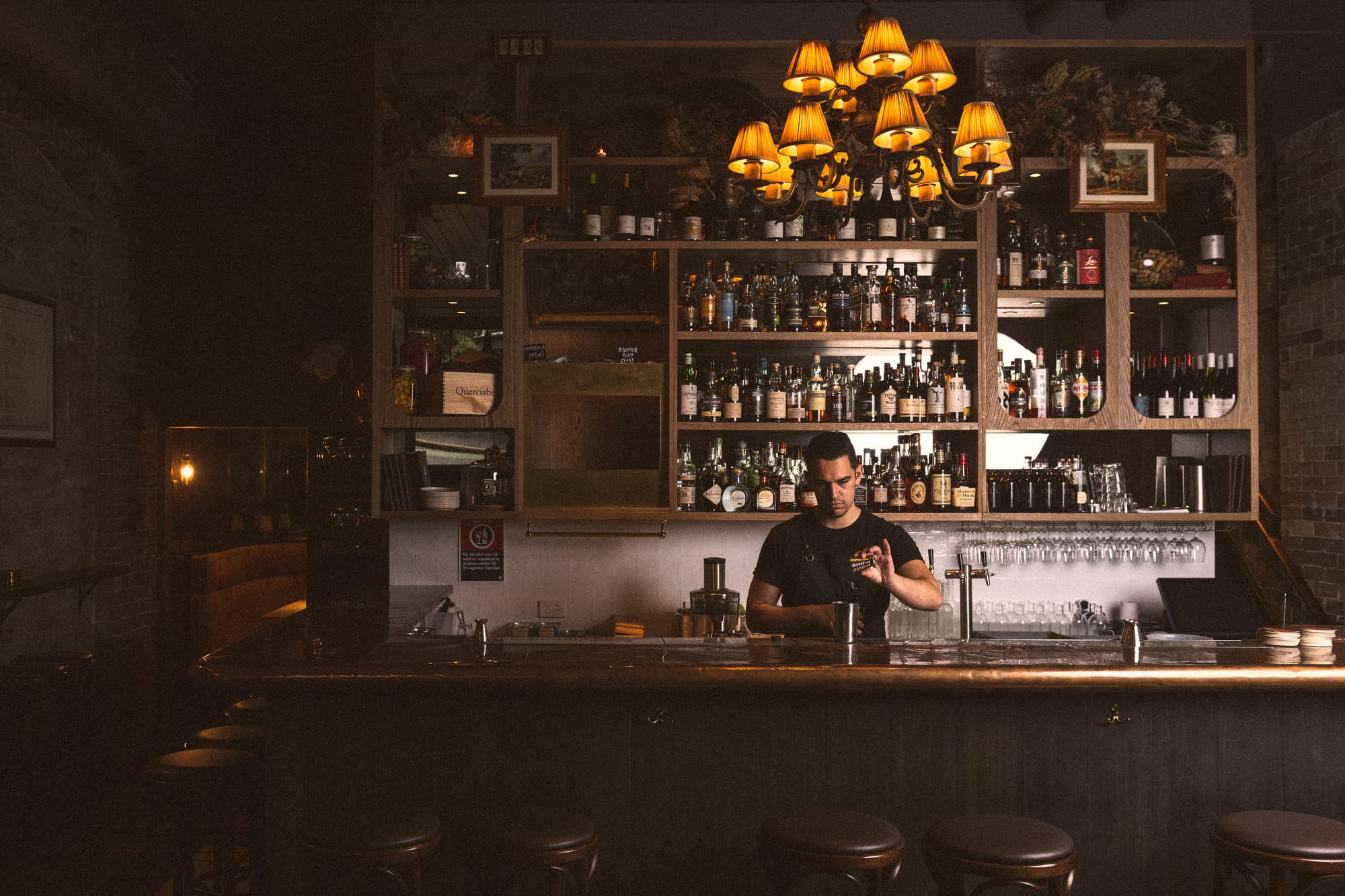How Alex Gondzioulis makes menus across four venues (including their latest, Alfie’s)
“When it’s a new venue, I’m going to write that list start to finish to set the tone,” he says.

MADE POSSIBLE BY

Like a good cocktail itself, writing a cocktail menu that works requires balance.
That’s something that Alex Gondzioulis knows a bit about. Alex is the group bars creative lead for the Liquid & Larder group in Sydney, whose venues include restaurants Bistecca, The Gidley, and the newly-opened Alfie’s, as well as Surry Hills bar The Rover. He’s a former Bartender of the Year winner, and came to the group after a long stint at the much-missed Bulletin Place.
And Alex was involved in two drinks on 2023’s Drink of the Year Awards Top 50.
So yeah, he knows a thing or two about good drinks.
In the video here, and the lightly edited and condensed interview below, Alex explains how he goes about creating the drinks lists for each of the venues in the Liquid & Larder group, how he collaborates with the venues, and when he needs to set the tone himself.
As he says: “I wear a lot of different hats.”
Sam Bygrave: Tell us about your role and the venues in the group?
Alex Gondzioulis: I am the group bars for the Liquid & Larder group. So less of a manager, more of a, I guess, creative lead to a degree. So I oversee everything from training from the bar side of things to really looking at like what products we’re putting out over the bar, what we’re arranging, do the drinks that we are offering on the list fit whatever the brand ethos is for the venue. I make sure that everything is in line and also that during service it’s being communicated but also served properly, effectively to standard across the group. So I wear a lot of different hats.
I work with the quality team [in the company]. So we have a group somme, who does the same thing on the wine side of things. We have group guest service, which does much more of the sequence of service in the restaurants. And our exec chef who does everything kitchen. We all oversee quality.
The group itself has four venues. We did used to also have Grandma’s, which was the first venue that [group owners] James [Bradey] and Warren [Burns] opened.
The OG small bar.
It was one of the first ones. I think it was the fourth to get the small bar licence in New South Wales. I think the only one in those four that’s still open right now is Shady Pines Saloon. So that says a lot.
Grandma’s unfortunately shut August of this year. The building got sold, someone’s developing the block. These things happen.
Out of your control, right?
Pretty much, yeah.
So list off the venues for us.
So we had Grandma’s shut this year. We’ve got The Rover — used to be called The Wild Rover — it went through a refurb last year. A bit of a growing up transformation. We’ve got Bistecca, which is our flagship, a Florentine steakhouse.
Impossible to get a reservation.
But you can sit in the bar and have one of the best selections of Amaro in the world.
There you go.
And we’ve got The Gidley, which is kind of our own Keen’s Steakhouse, Peter Lugar kind of thing, New York sort of — I hesitate to use the words gentleman’s club — but that sort of dark, opulent, decadent.
It sort of nods to that kind of feel.
Absolutely. Heaps of American whiskey, you know, premium tequila.
And then we’ve just opened six weeks ago — though it does feel longer than that — where we’re sitting right now which is called Alfie’s, which is a bit of a departure to what the guys have done in the past.
If you look at venues like The Gidley, venues like Bistecca, it’s lower covers, higher per head spends, two-hour sittings. Alfie’s is built for speed, built for pace, built for convenience. You can get in and out, have a steak here in an hour.

Which is a pretty big promise to make, right?
Yep. We get a daily report sent through and I read it, and says steaks are coming out in 15 minutes, “oh we got slammed 12 to 12.30, 17 minutes. But we pulled it back.” So the goal is to have the steak on the table in 15 minutes. Then you’ve got a good 45 to 60 minutes to enjoy it.
How do they how do they manage to do that? It’s completely off topic, but how do they manage to get it out in 15 minutes?
So I guess you when it’s lunch I guess well, we know roughly bookings for sure so we can have an idea of how much we’re gonna do. There’s only one option, it’s the sirloin. It’s 220 grams. It’s cooked to medium-rare. We can leave it on the grill a bit longer if someone wants it more cooked than that.
The guys in [the kitchen] have these big — if you’ve ever seen the restaurant firedoor, they’ve got those grills that can go up and down. Two of those about the size of this table, over charcoal. And you’ll see at 12 maybe even 11:45 there’s a guy, he just pulls out a drawer of steaks, I shit you not it’s a drawer of steaks, refrigerated drawer of steaks and it’s just...
The idea is that we already know what people are gonna order, so let’s just make it happen, you know?
That’s cool. Talking about that sort of express speed of service, have you had to think about that for the Alfie’s drinks list?
For sure. When we sat down to first talk about the venue, Warren, who’s one of the owners of the company, is also the head of the quality arm of our company. He said we wanted drinks out on the table in four minutes.
Wow.
Which is like, Bulletin Place, where all we did is serve cocktails, we had an eight minute check time rule — so it’s half that.
And has that carried through?
Pretty much, yeah. Especially if you’re ordering from the menu. If it’s a menu serve, then we can get it out pretty quick because we’ve built it around that.
What have you had to do to make that work for the menu?
I guess we’ve taken aspects of what we’ve already done at other venues. We’re pretty batch heavy as far as the group goes. Drinks that are served on draft, like Old Fashioneds or Negronis, Spritzes on tap. Drinks that are served in those plastic PET bottles that we force-carbonate. So the whole thing’s done, all we really need to do is assemble.
The Martini as well, There’s probably been a heap of press around that but we keep it really cold but it’s essentially finished.
This is supposedly the coldest martini in town.
Arguably. Bring your thermometer and then don’t tell me about it.
I’ve had it, it’s pretty damn cold.
It does what it says on its tin. It’s all about doing a lot of the hard work behind the scenes, so that when it comes to service, assembling the drinks is relatively simple and it’s about making it look good or the way that we want to serve them at the table — we can have those little bespoke moments without taking forever to get everything done.

How much planning had to go into this menu then to have that execution at the end of the day?
I work seasonally. So, you know, if you come in and you find that the market’s saying [that] mangoes are great, which they are right now, you’re probably going to process mango in a particular way with particular flavours, X, Y, Z.
But in terms of planning the menu itself, I don’t think the process was particularly drawn out. I knew that I wanted — and I do this across the group — to have these like tentpole drinks that aren’t gonna change or at least, the position it occupies in the menu isn’t gonna change.
So we’re in a restaurant right? It’s not a small bar where people are coming expressly for our cocktails. It’s part of a wider experience.
So when you’re writing a restaurant menu, I find you’ve got to have an Old Fashioned, a Martini, maybe a Negroni, something light and Spritzy. So if you plan those as your tentpole drinks that are going to be more or less evergreen, then you can get a bit weird with everything else.
What is it about those drinks that you have to have them for a restaurant?
A lot of them lean more to the aperitif or digestif side of things.
Okay, how do you think about structuring the menu? Are you looking at different types of glassware?
When it comes to structuring a menu you’ve got to think about, and this is all stuff that I kind of learnt a lot at Bulletin Place, because we had five drinks every day that changed, but how you plan that menu would dictate how your night went.
Tell me about that.
I guess there was a really quick, positive or negative feedback loop depending on the choices you made. You would have to write your menu the night before, turn up at midday, one o’clock, prep for three or four hours to get enough for the day and then come downstairs, set up the bar, physically hand write the menu up and then you were making drinks all night. You did that once a week, that was a big shift.
It’s a big undertaking though.
Yeah, 100%. It teaches you a lot. But it also meant that if you were a bit newer to it and you either bit off more than you could chew on a prep side of things, then you found yourself having to either rewrite drinks or really scramble at the end. If you didn’t plan properly in terms of glassware, like if you went, I’m gonna do three drinks in coupes or stemware, you’re gonna run out pretty quick.
So we look at making sure that we’re not favouring one [type of] glassware too much, or if we do, we’ve designed the bar around having heaps of that available. A good balance is, if it’s eight or 10 drinks, maybe two of each using the same glassware.
And then a balance of flavours and styles as well. You don’t want to have a bunch of drinks that are stirred and boozy because inevitably someone’s going to walk through the doors that doesn’t drink like that and there’s nothing for them on the menu. And you either have to go off-menu and serve classics, which is great, but not everyone knows their classics as good as the next guy. Or you’ve got to kind of go, how about not a cocktail? Which is not really what I’m about.
Because you’ve got responsibilities across the group, I noticed you had a couple of drinks in the Boothby Drink of the Year Awards that we held recently.
And they were collaborative too.
They were collaborative, right? So can you tell me a bit about that process, how you work with people?
So I guess the process for menus across the group has changed a lot since I started. I’ve been in the job for getting on three years now. And when I started, it didn’t seem like there were tons of systems in place on how you get a drink on the list, what the expectation is.
And we were refurbing The Rover and then working towards [Alfie’s]. Generally speaking, when it’s a new venue or a new concept or whatever it is, I’m going to write that list start to finish to set the tone.

Gotcha. So that’s what’s happened here at Alfie’s?
That’s pretty much what’s happened here at Alfie’s. It happened at The Rover and then it happened to a lesser degree but still quite considerably at The Gidley and Bistecca when I first came on board. I saw what we were doing well and what we weren’t doing so well and I had a kind word to the managers.
I was like, just let me show you what I’m looking for, and we’ll see how it works, and then assess moving forward.
Since then, basically every three or four months, [we] change the majority of the list.
And this comes back to your seasonality kind of thing?
Exactly, so we work, we wanna make sure that, aside from those tentpole drinks, which tend to lean a little bit more spirit forward, we want some fresher, lighter, more seasonally driven serves that also keep people coming back.
I guess the other side of it is, [that] it keeps bartenders engaged because they get to serve new drinks semi-regularly.
Back to the process that I do though, basically every three or four months I sit down with the bar manager. It starts with, “The venue name’s drinks are...” and then we’ve got three statements saying what our drinks are about at each venue.
It’s like a mission statement?
Pretty much. So Alfie’s drinks are served sharpish, which means quickly; they are approachable, so we’re not using flavours that are too weird or hard to explain because, again, people are here for a good time, not a long time; and then the other thing that our Alfie’s drinks do, which is a bit harder to define, is that we under promise and we over deliver. So the visual style of the drinks is relatively pared back with the idea that they’re gonna get the drink in front of them, have a taste and go, wow, that’s awesome. We want to play with their expectations, or have the drinks look a little bit more minimal and pared back so that the flavour really speaks for itself.
Tell us about the collaboration stuff in the other menus that you’ve done.
So once we’ve thrown the brief out, I’ll have a list of all the drinks that are currently on the list and it’s basically a red light, orange light, green light kind of situation. Red light, it stays, tentpole or it’s good or I know I can get this fruit for another three months. It’s not broken.
Yep.
Orange light is we could change it. We could do a slight tweak to improve it or a seasonal swap. Green light’s like get it gone — let’s start again.
The bar manager collates all the ideas from anyone who wants to contribute. And then I’ll sit down with the bar manager after two weeks, four weeks, whatever it is, and we’ll go through all the ideas. And that’s where I really kind of jump in and go, that idea is great, [but the] execution’s not really gonna quite work, or that idea is great, go with it, or [it’s] not gonna work — not right for us, maybe it might be a good drink on paper, but it doesn’t fit the brief.
So really what I’m trying to do there is not necessarily take complete control, it’s more to mitigate the amount of potential failures we could have in the R&D phase before it even starts.
Once we approve all the ideas, go make the ingredients that we’ve listed and let’s then call me in when you’re ready for me to taste something.
And then usually all things being equal, the bar manager will call me in, I’ll taste some drinks and we might do some tweaks here and there but you know we can get it right by five times at the most.
So five tries?
Yeah, if it starts to go past five goes it’s kind of like, I think we need to reassess this. Maybe there’s something wrong fundamentally and we need to redo it, which hasn’t happened too much.

